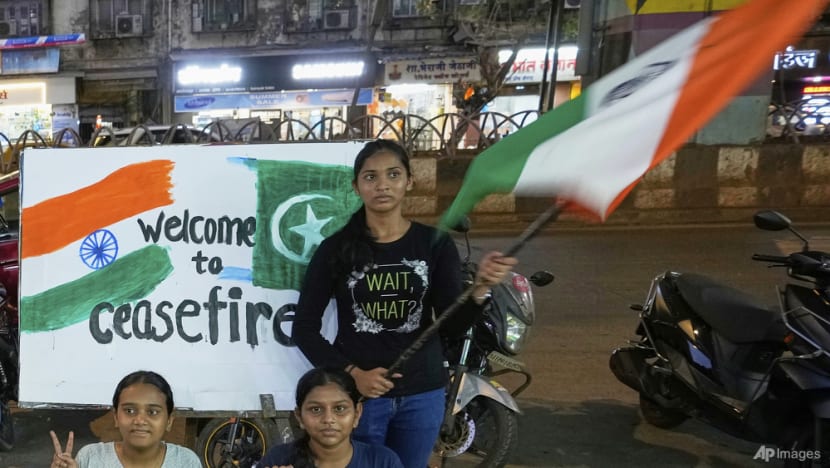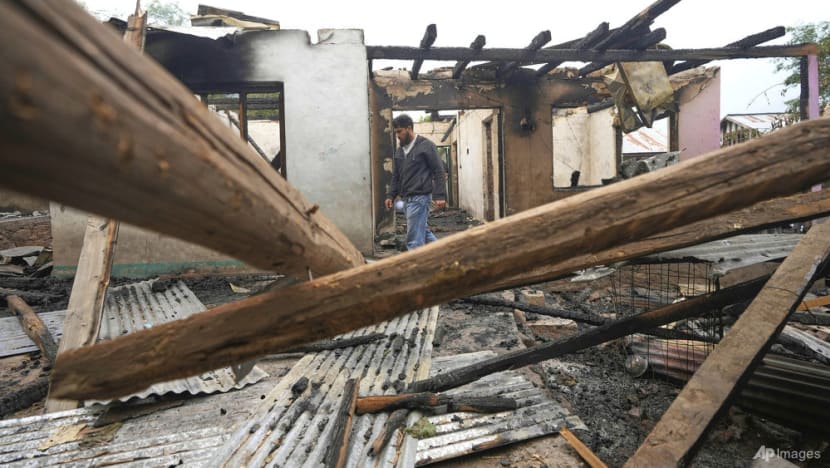Commentary: India and Pakistan are on a global charm offensive to tell their version of the conflict
Both sides are trying to impose their narrative of the four-day conflict in May. Dialogue appears to be a dead end, says Chietigj Bajpaee from the Chatham House think tank.

Students of an art school and their teacher celebrate the ceasefire between India and Pakistan, in Mumbai, India, May 10, 2025. (AP Photo/Rajanish Kakade)
LONDON: In the past fortnight, multi-party parliamentary delegations from India and Pakistan have stopped in London as part of a world tour. Having had the opportunity to interact with both delegations, one thing becomes abundantly clear: Dialogue is a dead end (for now).
They were essentially two sides of the same coin, each seeking to make the case for their nation’s narrative following the brief, 87-hour conflict in May.
Both sought to claim the moral high ground while painting the other side as the aggressor. Each resented any parallels or equivalency drawn between their positions. According to India, its actions were a response to the terror attack in Pahalgam that claimed the lives of 26 civilians. According to Pakistan, its military action was triggered by India’s military operation, while arguing that New Delhi has failed to offer the smoking gun of Pakistani complicity in the terror attack.
Both trumpeted their battlefield successes while downplaying their losses. The Pakistani side touted the loss of Indian aircraft in the initial military exchange, while the Indian side downplayed this, noting that such losses should be expected as part of any military campaign (and refusing to admit to any specific losses). India also played up the strength of its air defences in repelling Pakistan’s counterattacks and the concomitant weakness of Pakistan’s air defences.
Both emphasised red lines. For India, another terror attack would trigger a war. For Pakistan, any violation of the Indus Water Treaty would do the same. The Indian delegation noted that India had dropped its previous “hesitation” of deploying hard power, while the Pakistani delegation accused India of “dragging water onto the battlefield”.
Each side offered differing conditionalities on returning to the negotiating table: New Delhi will only discuss the issue of terrorism and Pakistan-administered Kashmir, while Islamabad wants to focus on the water treaty and Indian-administered Kashmir.
Both countries are seeking to internationalise the conflict, but in different ways. For India, the emphasis is on framing Pakistan as the epicentre of global terrorism (with reminders of Osama bin Laden being killed in Pakistan in 2011 and Wall Street Journal journalist Daniel Pearl being beheaded in Pakistan in 2002). For Pakistan, the emphasis is on getting third party “facilitators” rather than “mediators” (given New Delhi’s rejection of third-party mediation).
AMERICA’S DEFAULT RESPONSE
Ultimately, both countries face similar dilemmas in getting their message across to the international community.
For India, the global war on terrorism has lost the resonance it once had, making it difficult for New Delhi to make the case to the world of the severity of Pakistan’s threat to global stability.
For Pakistan, the effort to get United States or Western involvement in India-Pakistan hostilities and the issue of Kashmir is an uphill battle given the plethora of international (and domestic) crises presently confronting Western capitals.
This will not stop Islamabad from trying to do so as demonstrated by Army Chief Asim Munir’s visit to Washington this week, which demonstrates Pakistan’s ability to leverage global issues – from the Sino-US rapprochement in the late 1960s and early 1970s to the Soviet invasion of Afghanistan in 1979 and into the 1980s and the US-led “War on Terror” in the 2000s – to advance its primary foreign policy objective of strengthening its position vis-a-vis India.
Now Islamabad is seeking to do so again by leveraging the Trump administration’s efforts to obtain Islamabad’s support in the conflict between Iran and Israel (given that Pakistan shares a border with the former).
Trump’s “sphere of influence” worldview makes it unlikely that the United States will play any substantive or lasting role in South Asia.
While Trump claims to have applied pressure on both countries to initiate a ceasefire on May 10 – which has been denied by India – his initial nonchalant response (noting that both countries would sort it out “one way or the other”, which was supplemented by Vice President JD Vance’s comment that the conflict was “fundamentally none of our business”) reveals what is likely to be the default response to future hostilities, as long as they stay below the threshold of a nuclear conflict.
South Asia has lost the strategic significance it once had following the US-NATO withdrawal from Afghanistan in 2021.

TALKING PAST EACH OTHER
In this context, the world tours by parliamentarians from India and Pakistan appear more focused on appeasing domestic political constituencies than any genuine effort aimed at shifting global public opinion. There was more emphasis on dictating each country’s position rather than engaging in a genuine dialogue.
All this limits the prospects for any peace process.
The Pakistani delegation pushed for the resumption of a “comprehensive dialogue”, but what would both sides discuss when they are essentially talking past each other? They cannot even agree on the facts of what happened, accusing the other of misinformation, hyper-nationalistic rhetoric and religious extremism.
The Indian side accused Pakistan of employing “terrorism as an instrument of state policy” while the Pakistani side claimed that the Modi government wants to “eradicate” India’s Muslims. This makes it impossible for both countries to sit down together.
NUCLEAR DETERRENCE IS WORKING
If there is any silver lining it is that among the world’s flashpoints, India-Pakistan hostilities still seem relatively contained despite the bad blood in the bilateral relationship. The short four-day conflict and emphasis on precision-strike operations contrasts with conflicts in Ukraine and the Middle East where there has been significant collateral damage and prolonged and expansive military operations across multiple theatres.
This shows that nuclear deterrence is working in limiting the threshold of violence, although this threshold is being tested and eroded as both countries find new ways of targeting each other, from sponsoring irregular separatist/terrorist outfits to developing drone and cyber warfare capabilities.
As a result, South Asia is in an interesting position, a region that is the most vulnerable to a nuclear exchange, and hence, ironically the most restrained of the world’s major flashpoints.
Dr Chietigj Bajpaee is senior research fellow for South Asia in the Asia-Pacific Programme at Chatham House. This commentary first appeared on the Lowy Institute's blog, Interpreter.
















